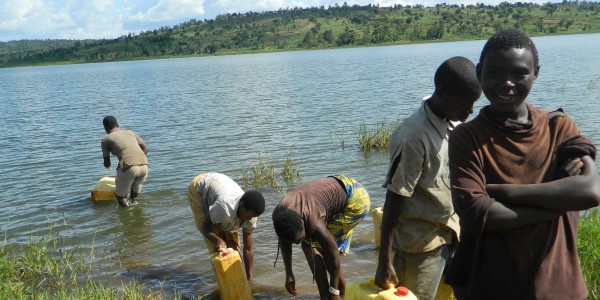Population growth and the need to sustain livelihoods put pressure on the natural environment. The dependency from agriculture caused over-cultivation there by leading to land degradation, soil erosion and pollution. The area lacks piped water systems and communities depend on the lakes water, with more and more degraded quantity and quality. But it was not only the water and agricultural sector that was challenging people’s life’s. The need to cut trees for firewood as energy sources further degraded the land and diminished sources of wood. All these challenges are increasingly difficult to manage in the transboundary context.
Actions Taking
The Global Water Partnership is tackling these challenges through its Water, Climate and Development Programme (WACDEP), a program implemented in the Bugesera region which started in 2011.
Stakeholders were mobilized from both countries to analyze the situation who then agreed on the following actions that were implemented by the communities.
To increase land protection and food production, a buffer zone at the lake was established through afforestation of 30 hectares with 36,000 drought resistant trees. The water situation was tackled by 8 new water points connected to 2,500 m of supply network serving around 3,000 people. Additionally, the communities where organized into water committees and trained to manage the water points. To decrease the dependency from firewood and thus decrease deforestation, fuel saving stoves and biogas was introduced. The people were trained to produce 1,000 fuel saving stoves and 11 biogas digesters were installed including rainwater harvesting tanks used to produce biogas.
In addition to these measures, technical capacity development trainings were held. The objective was to learn how to prioritize no and low regret solutions and to make a clear economic case for investment options.
The success of climate adaption and sustainable management depends on stakeholder sensitization. Hence a media training was organized to raise awareness on water security and climate resilience.
Lessons Learned
- Linking policies with practice is useful in promoting water security and climate resilience.
- Considering the catchment as a unit of management and establishing mechanisms for cooperation in the entire transboundary level increases conservation of resources.
- Communities need water for various uses, therefore it is important to integrate their concerns into the planned approaches and demonstration activities. This increases ownership of the activities on the part of the communities as access to water becomes easy.
- The success of the WACDEP can be attributed to the continuous and meaningful involvement of communities and all relevant stakeholders in both countries.
- Early participation and ownership by all stakeholders are needed for the sustainability of a project and provide lessons for future replication.
- Community catchment management structures are critical as they enhance empowerment and ownership and buy-in for tangible results.
- Solving water problems is not only a task for the water sector. It requires interventions in water-using sectors such as agriculture, the energy, industry etc. All these sectors impact the quality and quantity of water resources. The impacts between these sectors and how they can be tackled is key in successful implementation of projects like WACDEP.

